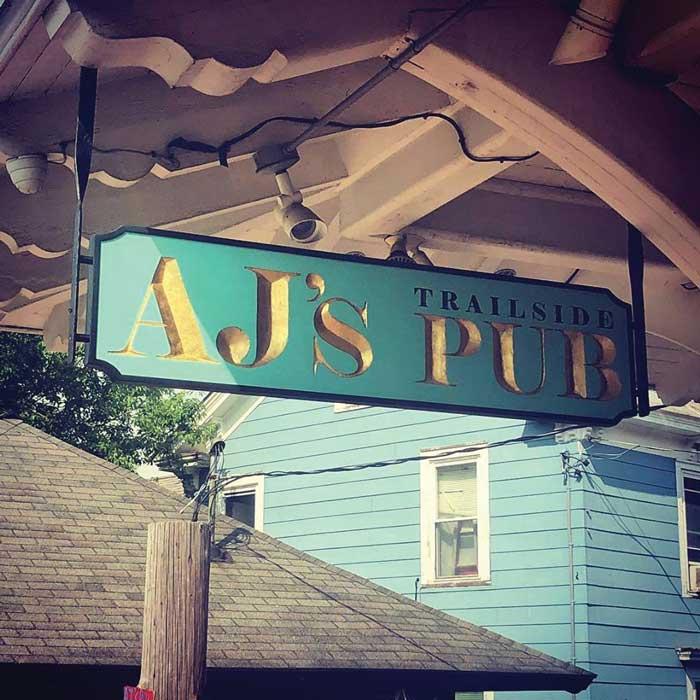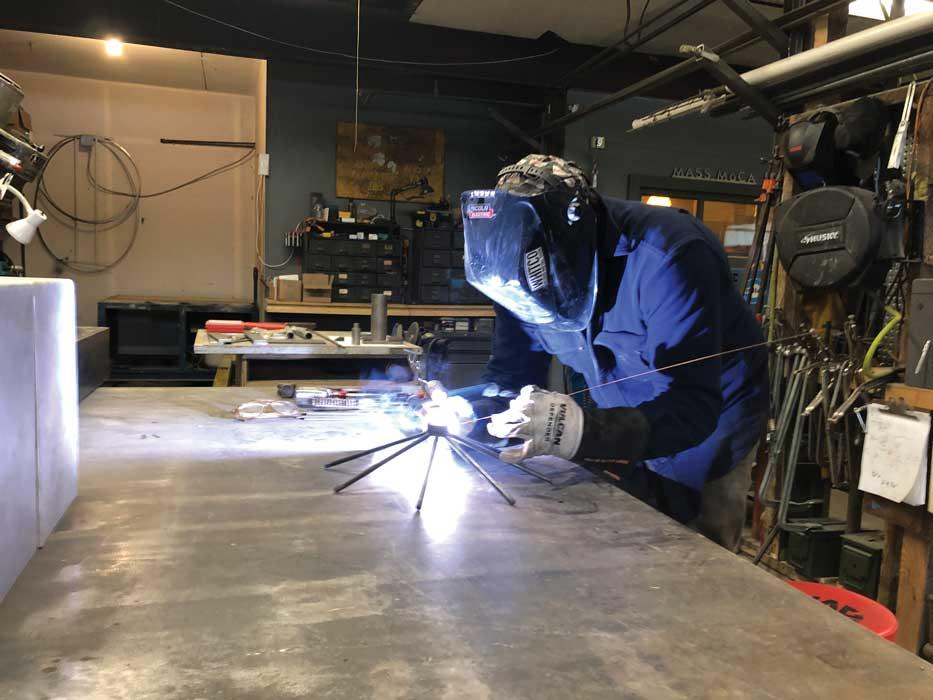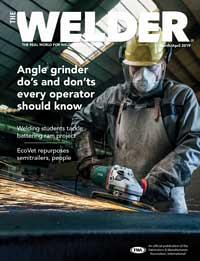- FMA
- The Fabricator
- FABTECH
- Canadian Metalworking
Categories
- Additive Manufacturing
- Aluminum Welding
- Arc Welding
- Assembly and Joining
- Automation and Robotics
- Bending and Forming
- Consumables
- Cutting and Weld Prep
- Electric Vehicles
- En Español
- Finishing
- Hydroforming
- Laser Cutting
- Laser Welding
- Machining
- Manufacturing Software
- Materials Handling
- Metals/Materials
- Oxyfuel Cutting
- Plasma Cutting
- Power Tools
- Punching and Other Holemaking
- Roll Forming
- Safety
- Sawing
- Shearing
- Shop Management
- Testing and Measuring
- Tube and Pipe Fabrication
- Tube and Pipe Production
- Waterjet Cutting
Industry Directory
Webcasts
Podcasts
FAB 40
Advertise
Subscribe
Account Login
Search
The art of sign-making
A Massachusetts fabricator finds his niche, puts bevy of skills on display
- By Amanda Carlson
- March 14, 2019
- Article
- Arc Welding

Brent Whitney’s sign-work is a culmination of the painting, drawing, and metalworking skills he’s developed over a lifetime.
The art of sign fabrication is like any form of artistic expression. It requires a creative mind, a skilled hand, and a level of self-awareness that allows the artist to build to his or her strengths. Sometimes the artist has complete creative control, while other times he or she must design and fabricate according to specifications doled out by design teams.
Brent Whitney of Adams, Mass., didn’t reach these conclusions by following a straight path. There were plenty of twists, turns, struggles, and aha! moments along the way.
Always known as being the artist, Whitney worked as an intern at the Massachusetts Museum of Contemporary Art (MASS MoCA). He was in school and earned an associate degree in visual arts from Berkshire Community College before focusing on sculpture at the University of Massachusetts.
“I originally went to UMass for painting and then switched to sculpture when I took this metals course. It was basically an introduction to welding—mostly MIG—and blacksmithing, and I really got into it. I have always been interested in metal. We didn’t work with a lot of metal at MASS MoCA at the time, but I realized that my sculptures would eventually be made out of metal,” Whitney explained.
After completing college, Whitney attempted to obtain a job as a welder, but found it difficult to merge into the trade, even at entry level. He applied for a minimum- wage job welding waste containers but didn’t get hired because his resume was all art related. It was at that point, he said, where he hit a wall and felt it necessary to hide his art background just to be given a chance to get a foothold in the metal fabrication world.
And then an internship opportunity came his way from Sam Ostroff of Salmon Studios, a sculptural metal and design firm in Northampton, Mass. It was perfect because Whitney got to meld his artistic abilities with his growing welding and fabrication skills. The internship went so well that Ostroff eventually offered him employment.
He Saw the Sign
The time he spent at Salmon Studios taught Whitney many skills in decorative metal fabrication. After 10 years being employed in the industry while working commercially for himself, Whitney eventually succumbed to the pull he’d been feeling to work only for himself.
“My company was growing. I had developed some clientele and it made sense to break away. I also was anxious to focus and build on my own thing.”
Whitney saw sign design and fabrication as the intersection of all of his specialties and experiences—his background in painting and drawing, his sculpting experience, his early days in fabrication at MASS MoCA, and the time he spent working in architectural metals at Salmon Studios.
“I had a desire for the architecture of sign-making and a yearning for beautifying my community. A lot of signs that I had seen were print-based and lacked design. I felt like a lot of small-town companies were being robbed because of cheap signage,” Whitney explained.

A lot of intentional design and correspondence went into the making of these four simple letters at Bright Ideas Brewing—BEER.
In a competitive market, Whitney has carved a niche with his ability to work in three dimensions. That, paired with his knack for functional design—a philosophy he gravitated toward while working on his thesis at UMass—is the foundational element of his work.
“Roman architect Vitruvius once wrote that a lion is beautiful because there’s nothing unnecessary about it. It’s strong and functional. If you make something purely functional, that’s where you can achieve real beauty.”
Make no mistake, communicating and budgeting a functionally based design with clients is a challenge. For example, consider the sign he designed and fabricated for Bright Ideas Brewing in Adams, Mass. It comprises four simple letters made from aluminum plate that spell out exactly what people should expect to find at a brewery: BEER. But a lot of initial design work and correspondence went into this very simple concept.
Because of the location and flow of patrons, Whitney suggested that the letters be welded to have more body. This would have required a lot of welding and finishing, had the budget allowed for it.
Another challenge is working with a client who wants to incorporate their pre-existing logo onto a sign when it was never designed for that particular use.
“For example, 3D letters or carving the font has to correlate with the way you would cut a letter. You can’t use thin serifs or anything like that.”
It’s almost easier to take on a client who has no logo. Even though building a logo from scratch requires a little more legwork on his part, it’s easier in the long run because he can design it to fit his fabrication needs.
Whitney’s equipment comprises a vertical milling machine, horizontal band saw, two Miller Electric GTAW machines—an Aircrafter from the 1980s and a Lift Arc—blacksmith tools, an oxyacetylene setup, portable band saw, and soon a large lathe. He farms out anything that requires CNC plasma or waterjet cuts.
Taking the Good With the Bad
Pardon the cliché, but the grass isn’t always greener when you get to be your own boss.
“When you work for yourself, you want to work for someone else. When you work for someone else, you want to work for yourself,” he said.

Whitney has carved a niche with his ability to work in three dimensions. That, paired with his knack for functional design, is the foundational element of his work.
While he enjoys being his own boss, thus having total control and creative freedom, it didn’t take him long to figure out that along with the pros are the cons. Whitney now has no days off. He has to manage the business finances, which he admits is a challenge. He’s been broke for long stretches of time and still is uncomfortable juggling the strain of never feeling like there’s enough money to go around. And there was the initial realization that he was no longer part of a team.
“While I do have people that help me now, I went through a long stretch of being alone, especially in the winter for like weeks at a time. One of the guys I worked with at Salmon had his own thing for like five years and he didn’t go out or anything. He told me that he got weird because he didn’t get a chance to talk to anyone. Getting weird; I guess that’s a con,” Whitney laughed.
But there are pros. And when he’s feeling a little stressed, all he has to do is remember the work he’s doing throughout the community.
“I’ve developed the same passion for being of service to my sign clients as I do with my sculpture. I get to have a sense of purpose to help people using the skills and materials that I love.”
WHITCO, 413-652-5939, www.facebook.com/swietostudios
About the Author

Amanda Carlson
2135 Point Blvd
Elgin, IL 60123
815-227-8260
Amanda Carlson was named as the editor for The WELDER in January 2017. She is responsible for coordinating and writing or editing all of the magazine’s editorial content. Before joining The WELDER, Amanda was a news editor for two years, coordinating and editing all product and industry news items for several publications and thefabricator.com.
About the Publication
subscribe now

The Welder, formerly known as Practical Welding Today, is a showcase of the real people who make the products we use and work with every day. This magazine has served the welding community in North America well for more than 20 years.
start your free subscription- Stay connected from anywhere

Easily access valuable industry resources now with full access to the digital edition of The Fabricator.

Easily access valuable industry resources now with full access to the digital edition of The Welder.

Easily access valuable industry resources now with full access to the digital edition of The Tube and Pipe Journal.
- Podcasting
- Podcast:
- The Fabricator Podcast
- Published:
- 04/16/2024
- Running Time:
- 63:29
In this episode of The Fabricator Podcast, Caleb Chamberlain, co-founder and CEO of OSH Cut, discusses his company’s...
- Trending Articles
Sheffield Forgemasters makes global leap in welding technology

Welding student from Utah to represent the U.S. at WorldSkills 2024

Lincoln Electric announces executive appointments

Engine-driven welding machines include integrated air compressors

ESAB unveils Texas facility renovation

- Industry Events
16th Annual Safety Conference
- April 30 - May 1, 2024
- Elgin,
Pipe and Tube Conference
- May 21 - 22, 2024
- Omaha, NE
World-Class Roll Forming Workshop
- June 5 - 6, 2024
- Louisville, KY
Advanced Laser Application Workshop
- June 25 - 27, 2024
- Novi, MI



























